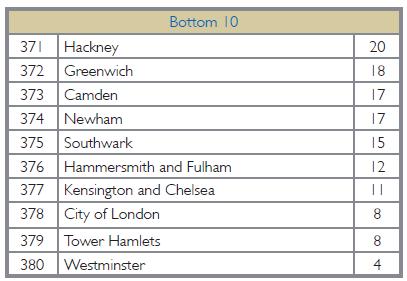Site search:
-
What’s new?
Energy for London Tags
Brent Buildings Camden Carbon Emissions CHP Cities Climate Adaptation Community Heating Community Initiatives Croydon Data DECC Decentralised Energy Distribution ECO Energy Costs Energy Efficiency Enfield FIT Fuel Poverty Funding Green Deal Hackney Haringey Housing Islington Lambeth Library Local Authorities Mayor Newham Ofgem Olympics Photovoltaics Planning RE:FIT RE:NEW Renewable Energy Retrofit Southwark Tower Hamlets Transport Waltham Forest Waste WestminsterEnergy Archives:
- February 2021 (1)
- January 2021 (15)
- December 2020 (15)
- November 2020 (9)
- October 2020 (3)
- August 2020 (5)
- July 2020 (3)
- June 2020 (4)
- April 2020 (10)
- March 2020 (5)
- February 2020 (2)
- January 2020 (3)
- October 2019 (1)
- September 2019 (4)
- August 2019 (2)
- July 2019 (1)
- August 2018 (1)
- November 2016 (8)
- October 2016 (8)
- September 2016 (2)
- August 2016 (8)
- July 2016 (14)
- April 2016 (12)
- March 2016 (16)
- February 2016 (8)
- January 2016 (4)
- December 2015 (1)
- November 2015 (1)
- October 2015 (16)
- September 2015 (3)
- June 2015 (1)
- May 2015 (1)
- April 2015 (1)
- March 2015 (1)
- February 2015 (1)
- January 2015 (1)
- December 2014 (18)
- November 2014 (4)
- August 2014 (8)
- July 2014 (7)
- June 2014 (25)
- May 2014 (8)
- April 2014 (4)
- March 2014 (12)
- February 2014 (7)
- January 2014 (13)
- December 2013 (11)
- November 2013 (15)
- October 2013 (15)
- September 2013 (18)
- August 2013 (5)
- July 2013 (20)
- June 2013 (33)
- May 2013 (8)
- April 2013 (16)
- March 2013 (25)
- February 2013 (14)
- January 2013 (20)
- December 2012 (23)
- November 2012 (23)
- October 2012 (25)
- September 2012 (14)
- July 2012 (12)
- June 2012 (43)
- May 2012 (20)
- April 2012 (8)
- March 2012 (40)
- February 2012 (39)
- January 2012 (40)
- December 2011 (22)
- November 2011 (40)
- October 2011 (33)
- September 2011 (48)
- August 2011 (40)
- July 2011 (58)
- June 2011 (41)
- May 2011 (80)
- April 2011 (38)
- March 2011 (33)
- February 2011 (25)
- January 2011 (24)
- December 2010 (3)
- November 2010 (7)
- October 2010 (6)
- September 2010 (7)
- August 2010 (1)
- July 2010 (2)
- June 2010 (4)
- May 2010 (1)
- March 2010 (3)
- February 2010 (3)
- December 2009 (5)
- November 2009 (2)
- October 2009 (3)
- July 2009 (3)
- June 2009 (1)
- April 2009 (1)
- March 2009 (1)
- February 2009 (1)
- January 2009 (1)
- December 2008 (2)
- October 2008 (1)
- September 2008 (1)
- July 2008 (1)
- March 2008 (2)
- January 2008 (2)
- October 2007 (1)
- September 2007 (3)
- July 2007 (1)
- March 2007 (1)
- February 2007 (3)
- November 2006 (3)
- August 2006 (1)
- February 2006 (1)
- May 2005 (1)
- February 2004 (1)
Tag Archives: City of London
2040 Net Zero Carbon London
January 2021: An open event organised by the Central London Energy Management Group (CLEMG) to be held on Thursday 18 February 2021 at 4pm which will will focus on the City of London and their plans to decarbonise. Full event registration details on eventbrite. The City of London Corporation published their detailed Climate Action Plan in October 2020 and is available to download here.
Climate and The City
1 January 2021: Good to see the Lord Mayor of London highlight the role the ‘City’ will have to play in terms of tackling climate change this coming year.

The City of London has recently adopted a Climate Action Strategy and undertook a number of innovative actions in 2020 – including securing a long terms renewable power purchase agreement (PPA).
City Corporation introduces the world’s first development guidelines on thermal comfort

15 December 2020: An interesting new initiative by the City of London who have issued planning guidance to developers on the impact of their developments on the immediate environment, which is particularly relevant to tall buildings which dominate the ‘square mile’. The press release sets out that the “‘Thermal Comfort Guidelines’ are believed to be the first of their kind globally, and will see data on wind, sunlight, temperature and humidity analysed on a seasonal level to predict how the microclimatic character of a place will feel to the public once a scheme is put in place. Tall and major building developers will be required to take account of the potential microclimate and thermal comfort impacts at an early stage in the design process.The analysis will allow for improvements to the quality of outdoor spaces within the Square Mile to better the health and wellbeing of residents, workers and visitors, as well as improving the experience of walking and cycling in the City.”
The guidance can be accessed here (direct download here). Some of the issues of tall buildings in London and their impact on the local environment have been highlighted over the past few years by Dr Julie Futcher and her ‘climate change walks’. More on Julie’s work here and here.
Posted in News
Tagged Buildings, City of London, Planning
Comments Off on City Corporation introduces the world’s first development guidelines on thermal comfort
City of London Wants to Clean Up the World
20 November 2020: With reference to the Prime Minister’s 10 Point Plan announcement earlier this week – which included a goal to make the “City of London the global centre of green finance” a Bloomberg Opinion piece on how Britain is aiming to be a hub for carbon credit and green derivatives trading. “London… has a history in cutting-edge finance, a deep talent pool and a strong lead in the trillion-dollar swaps market. It’s a logical place to base the trading of carbon credits, and the derivative-like contracts that companies’ would want to tailor for their individual needs, were the worldwide carbon credit market to take off.” Read the full article here.
Unfortunately, it’s far from certain that it will.
Posted in News
Tagged Carbon Emissions, City of London, Green Finance
Comments Off on City of London Wants to Clean Up the World
Fuel Cell in the City
February 2016: Neil Pennell, Head of Engineering and Design, at Land Securities discusses how the City has embraced the need for efficient design and eco-friendly power generation, highlighting the One New Change development – which uses a ground source heat pump, and 20 New Fenchurch Street (‘walkie talkie’) tower, which utilises a fuel cell. Read Neil’s blog here. Specifications of the fuel cell can be seen here. More on fuel cells in London here.
Posted in Decentralised Energy, News, Renewable Energy
Tagged City of London, Fuel Cells
Leave a comment
Councils should use bonds to fund green infrastructure projects
28 February 2016: The Independent reports on a further supporter for the use of Green Bonds to help fund green infrastructure.“Councils should use bonds to fund much needed green infrastructure projects such as renewable energy and flood defences, according to the Lord Mayor of London.” Two quick things to note here: first, the Lord Mayor of London is not the Mayor of London – but Leader of the Corporation of the City of London (one of London’s 33 boroughs) – a one year post largely undertaking ceremonial and social duties. Secondly, The Independent is actually quoting a former Lord Mayor – Sir Roger Gifford was appointed that post in 2012-13. The latest incumbent can seen here.
The Independent continues: “Sir Roger Gifford said there was tremendous scope for the country to follow the lead of the US and Swede, where municipalities have raised billions of pounds for green projects by selling bonds to the public. ..The city of Gothenburg launched its own green bond for a project and were flooded with calls from local people wanting to get involved,” said Sir Roger, an experienced financier who heads the UK division of Sweden’s SEB Bank, which managed the Gothenburg green bond. “I don’t see why that shouldn’t happen in Leeds, or Bradford, or wherever.” Gothenburg’s two green bonds have helped fund a number of projects across the city including water, biogas, district heating, and electric vehicle infrastructure.
“Sir Roger added: “There is great potential for the UK to follow the Scandinavian or North America models. Mostly obviously for wind, but also for wave, solar and biofuel power – all those forms of renewable energy are perfect for this kind of climate-friendly financing. Waste management, water management, better water grids, better electricity grids, sustainable transport, sustainable housing – all of them are also excellent, as is air-pollution prevention. His comments came as Swindon became the first council in the UK to issue a solar bond, a renewable energy bond, or a bond of any type to the public for more than a century.”“
Interestingly Sir Roger is also chairman of the recently launched Green Finance Initiative, launched on 16 January of this year “which aims to make London the world leader in green finance” – see full City of London press release here.
Posted in Decentralised Energy, News, Renewable Energy
Tagged City of London, Finance, London Councils
Leave a comment
London electricity infrastructure resilience concerns
December 2014: The House of Lords Science Science & Technology Committee have been conducting evidence sessions earlier this month for their current inquiry into the Resilience of electricity infrastructure.
Interesting to note that included in the written evidence provided to the Committee is a submission from the City of London Corporation (page 28 onwards). The Corporation’s main point is the “need for greater regulatory flexibility and more targeted investment and calls for better planning of the delivery of capacity in the system.”
The Corporation’s memorandum continues:
- It is clear that its [UKPN’s] network in London does not have available spare capacity to cope with future demand. This poses risks to future development and refurbishment cycles because developers and property owners are unable to be sure of the availability of electricity capacity. Further uncertainty results from the fact that it can take up to 3 years for substations to be reinforced and installation works completed so as to have sufficient capacity to supply a new building.
- The Corporation suggests that: “Given Ofgem’s existing regime does not incentivise investment ahead of need, new connections generally occur on an ad hoc basis, responding to immediate demand. The difficulty of creating such new connections at the last minute is hampered by the physical characteristics of the City (such as utilities congestion under the highway.”
- The Corporation is also critical of Ofgem’s determination of UK Power Network’s (UKPN) submission to the next regulatory framework period for investment (RIIO-ED1) – as summarised by Ofgem in the following press release. The Corporation states “Ofgem[‘s] proposed 12% reduction in the UKPN’s overall spending …would mean a loss of money available for investment in central London of around £200 million. This is highly likely to have a significant impact on UKPN’s ability to undertake a suitable level of network asset replacement work in the period 2015-2023. Cuts in investment are likely to lead to more widespread and frequent network outages due to the age of network assets.” Ofgem has in fact put pressure on all distribution network operator’s (DNOs) business plan submissions, and this drive down in UKPN’s cost proposals would not necessarily mean a direct reduction in investment in central London: it would depend on where UKPN apply savings to.
- The submission continues to highlight what it believes are further critical investment proposals within its territory to electricity infrastructure investment, calling on Ofgem to “reinstate this funding element in its final determination [to UKPN] in December 2014.”
The memorandum references research undertaken by the British Council for Offices which outlines that the forthcoming closure of the UK’s legacy generation plant and lack of available new sources of generation has increased the likelihood of blackouts from 1 in 3,307 years in 2012 to 1 in 12 years in 2015.
The submission makes a number of interesting points including “…the starting point for the verification of any case for investment ahead of need will be a clear overview of available DNO substation capacity in areas of high development growth. Regrettably this data is currently unavailable Ofgem and the Government should ensure that DNOs make this information publically available. It would be important to consider this data alongside information from developers, market details and Local Authority information.”
The Corporation of London’s evidence have been advised through research they have commissioned including – Delivering Power:The Future of Electricity Regulation in London’s Central Business District – and the Future of London’s Power supply. The Mayor has also written to the Secretary of State raising similar concerns over London’s electricity infrastructure.
Major London District Heating Scheme refurbished
March 2014: Some welcome news that E.ON are refurbishing the engines of their Smithfield-based Citigen Combined Heat and Power (CHP) district heating systems. The following Edina press release sets out 4 new major gas-fired CHP engines will be installed this year and commissioned by the beginning of 2015. Edina helpfully provide some background to the scheme:
 A City of London case study on the network is available here.
A City of London case study on the network is available here.
Posted in Decentralised Energy, News
Tagged CHP, City of London, Community Heating, Decentralised Energy
Leave a comment
Fuel Cells in London
November 2013: The Guardian highlighted in a recent story that the London HQ of Al Gore’s business is to be based in a new office development on Regent Street which has included a wide array of onsite energy measures installed including a gas-powered fuel cell.
“Climate campaigner and former US vice-president Gore said the £400m Quadrant 3 redevelopment showed a “sophisticated commitment to sustainability”. The headquarters of his sustainable investment company, Generation Investment Management, will be sited in the new buildings.
“The cell was developed by US company FuelCell Energy. It will emit 38% less carbon dioxide than using electricity from the grid and heat from gas-fired boilers, according to the crown estate, which says 350 tonnes of carbon dioxide emissions will be saved per year. Unlike fossil-fuel-burning power plants, the fuel cell produces power with virtually no nitrogen oxide (NOx), sulphur dioxide (SOx) or particulate matter (PM) pollution.
The new plant forms part of the central energy system that serves 500,000 sq ft of offices, shops, flats, restaurants and hotels in the Quadrant development.” Read the full Guardian story here.
Further detail on the installation of the fuel cell can be read here – which has been undertaken by Edinburgh based Logan Energy. The Quadrant 3 development has a number of other onsite energy measures installed (including a Combined Cooling Heat & Power plant, thermal stores and photovoltaics – see diagram below), as set out in the property brochure.
Another new London development to include fuel cell technology is that on 20 Fenchurch Street (more commonly known as the ‘Walkie Talkie’ building) which has installed a 300 kWe fuel cell, details of which can be read here and here.
Transport for London installed a fuel cell CHP in their Palestra building in Southwark back in 2010, details of which – including a video presentation – can be seen here and here.
Posted in Decentralised Energy, News
Tagged CHP, City of London, Fuel Cells, Southwark, Westminster
Leave a comment
Energy and Climate Questions to the Mayor
July 2013: This month the Mayor has been asked questions in relation to:
the Mayor and climate change denial; whether the Mayor will be publishing an update to his Climate Change Adaptation Strategy; if an audit of the London Energy Efficiency Fund (LEEF) will be undertaken; progress under LEEF; promotion of water efficiency measures; commissioning an energy security of supply study for London; the proposed Memorandum of Understanding between the Mayor and energy suppliers; Energy Performance Certificates (EPCs) and RE:NEW; confirmation of the single loan provided by LEEF; the Transport for London (TfL) energy strategy; TfL emissions action plan; clarification on the Mayor’s policy on waste incineration; fracking in London; the Mayor’s comments on climate prediction; differences between the Mayor’s comments on climate prediction and the London Climate Change Adaptation; the Mayor’s 2013/14 budget for climate adaptation; TfL climate risks action plan; the Mayor’s work with the insurance industry on building regulations; funding a health sector building to be climate resilient; climate risk information to Health & Well Being Boards; the Mayor’s commitment to look at overheating; work on risks related to flooding and critical infrastructure; flood risk data portal; surface water management plan for London; performance of the Green Deal in London; avoiding future electricity blackouts in London; weather data for London; work on the London Rivers Action Plan; developing community-led responses to heatwaves in London; buildings in London using cool-roof technology; studies with social housing groups on insulation and overheating; work with CIBSE on overheating in new developments; green roofs in London; helping offset the Urban Heat Island (UHI) effect in London; in light of the Mayor’s recent article – whether he will be abandoning Action 5.1 of his Climate Change Adaptation Strategy; an update on the London Drought Plan; the number of schools in London with rainwater harvesting systems; work on an intensive urban greening retrofitting pilot project to manage surface water flood risk; the work of the Drain London Forum; working with communities at flood risk; approved suppliers on the RE:FIT framework; the Citigen CHP scheme; how the Mayor will stop the Green Deal being a total disaster in London; Job losses in the insulation industry.
Previous months questions to the Mayor can be found here.
Posted in News
Tagged Carbon Emissions, City of London, Climate Adaptation, Energy Security, EPCs, Funding, Green Deal, Health, London Green Fund, RE:FIT, Transport, Urban Heat Island, Waste
Leave a comment
London bottom of solar league table
June 2013: Analysis by consultancy WSP in their report – ‘Solar Success: Space Not Cash the Key for Solar’ reflects previous posts by Energy for London (see here and here), highlighting London’s poor progress when compared to other regions in relation to the installation of solar photovoltaic systems.
The conclusions summarise the Feed in Tariff Installation report data, produced by energy regulator Ofgem, highlighting local authority installations per 10,000 households.
The analysis shows that London boroughs make up 23 of the 25 lowest ranking local authorities for solar installations and the entire bottom 10 in the national league table. Westminster, Tower Hamlets, the City of London, Kensington and Chelsea, Hammersmith and Fulham, and Southwark are all found in the bottom five.
The report points out that: “Even The Orkneys at 232/10,000 houses comes 55th out of 760 on installation rates – higher than every local authority in Surrey, Kent and London – areas which receive much more sun than Scotland. To get most bang for buck, incentives should encourage the sunniest areas to get more panels than the furthest north. This, however, isn’t the case – the reality of politics over good green policies.”
Reasons for London’s limited success with PV put forward include: “While we might think that cities should be happy hunting grounds for solar sales, in reality houses in towns are smaller, their roofs are more likely to be obscured and there’s also less owner occupation.”
London’s largest solar array
20 February 2012:
After a three year refurbishment, Blackfriars station has re-opened. As part of the station’s refit, Network Rail has installed 4,400 solar panels on the roof of Blackfriars station. Accounting for 50% of the station’s energy needs, they will form London’s largest solar array. Further information here and here.




